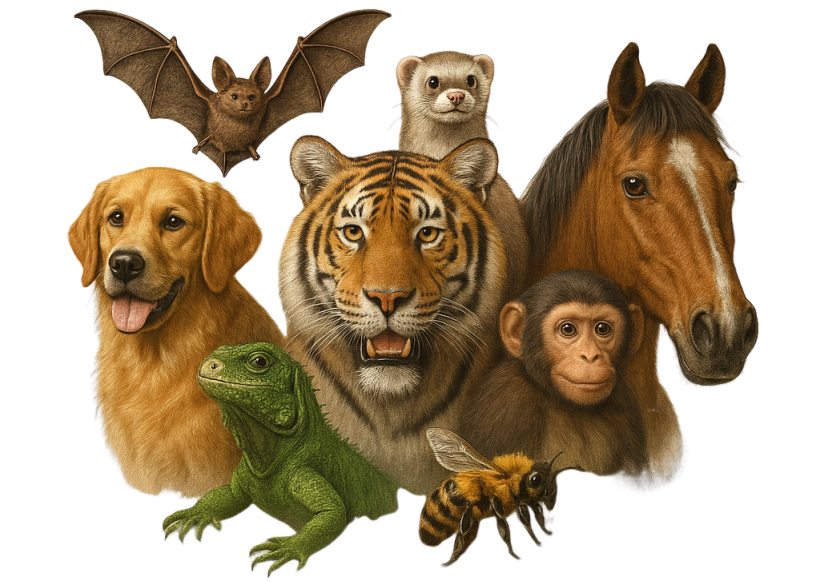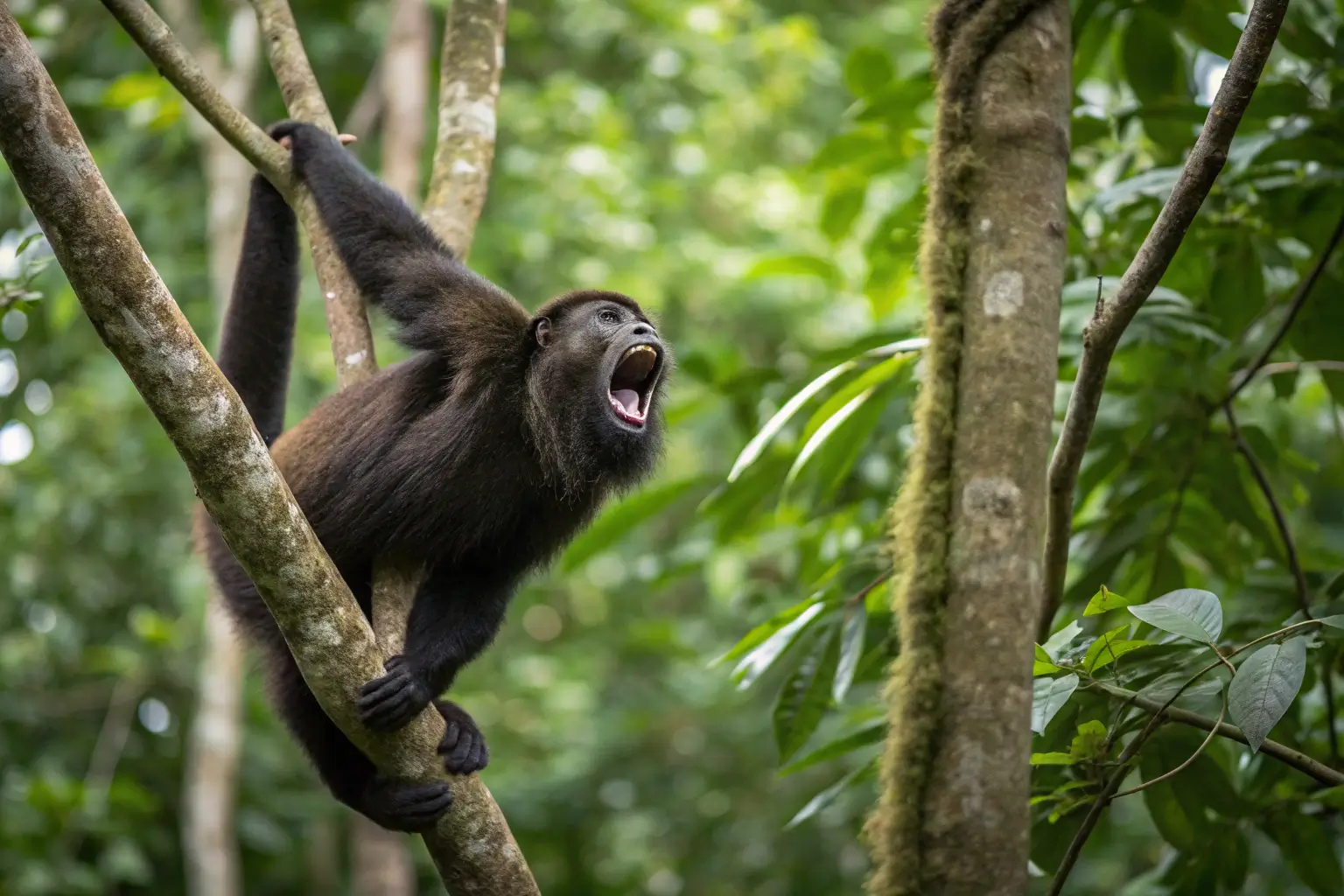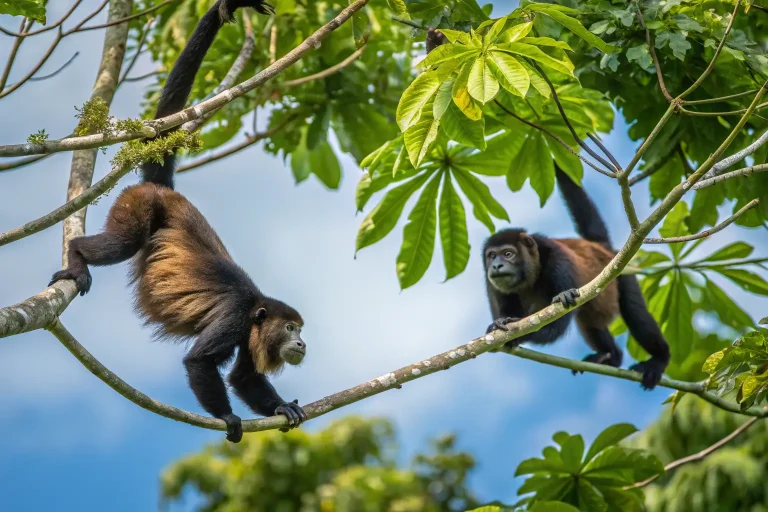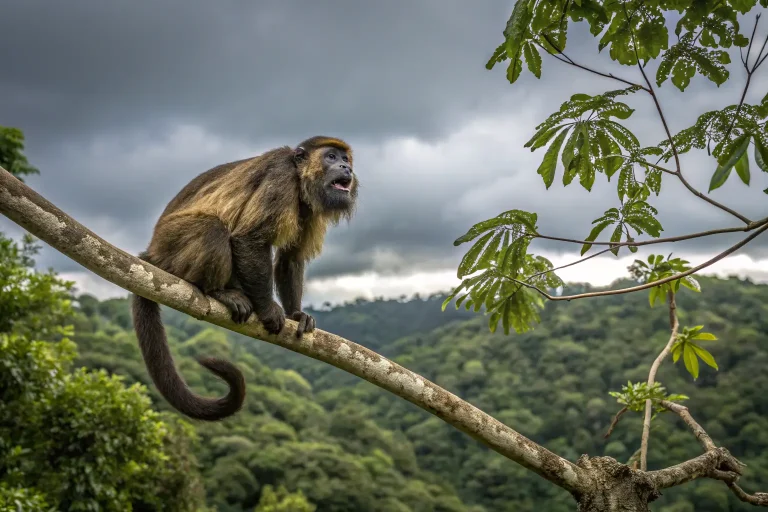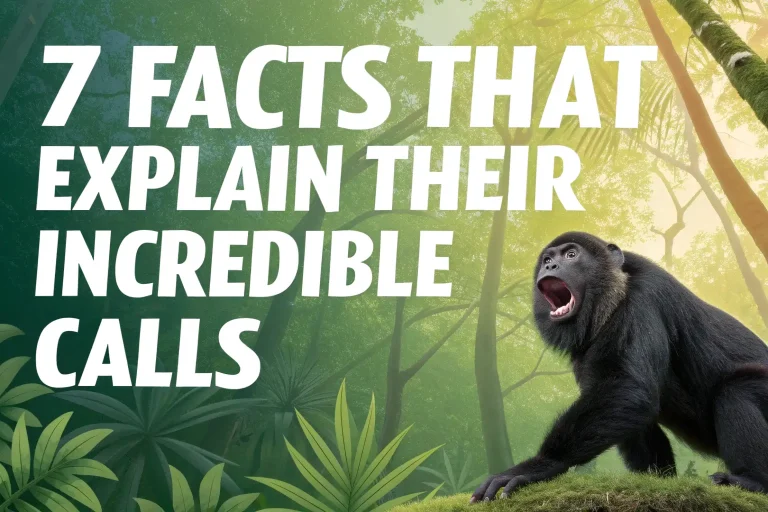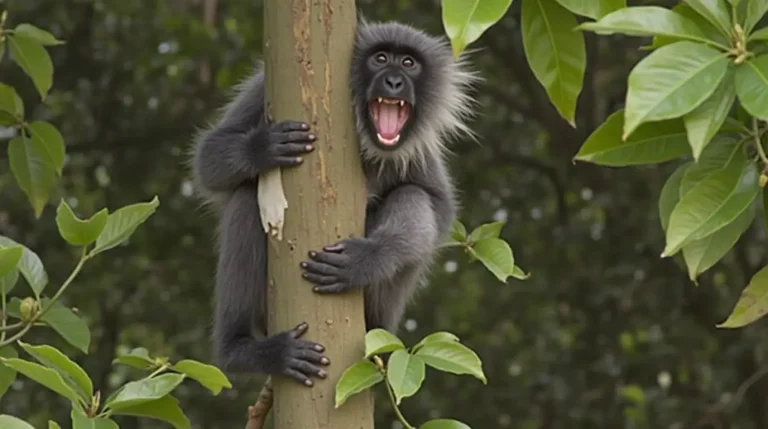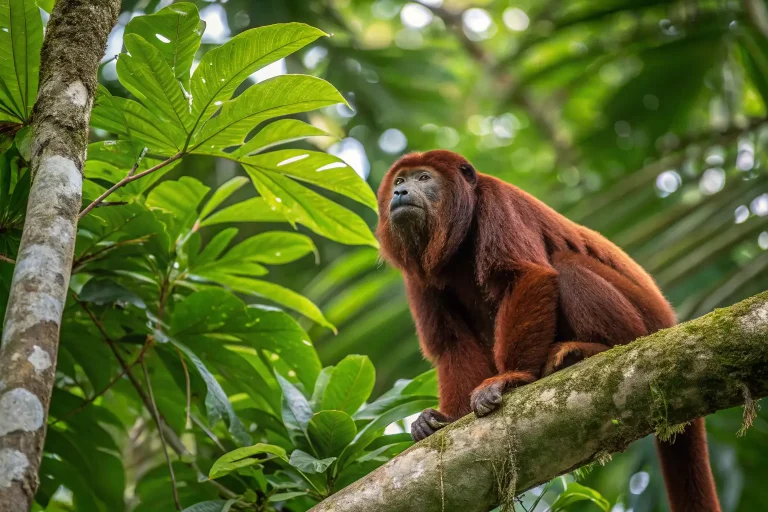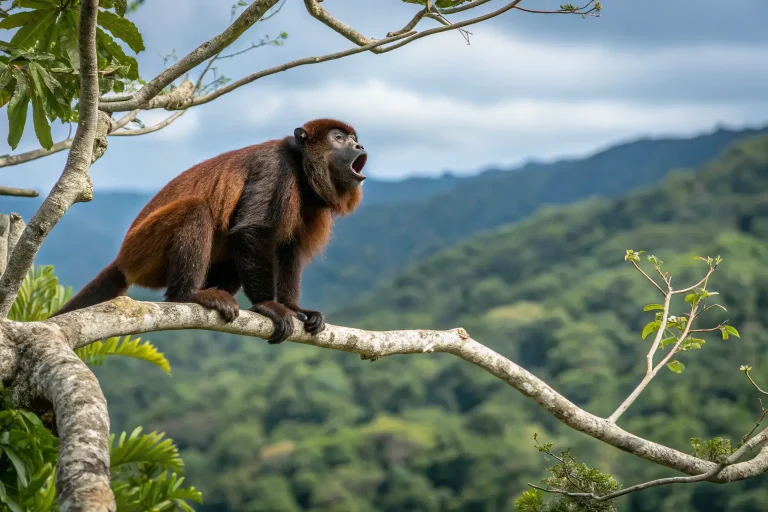What Does a Howler Monkey Sound Like? 7 Surprising Facts!
Ever wondered what does a howler monkey sound like? Dive into the world of these loud primates with 7 stunning facts that will amaze you. Learn their secrets!
Introduction
Deep in the lush rainforests of Central and South America, an extraordinary sound echoes through the canopy. It’s not thunder, not a jaguar, but the unmistakable roar of the howler monkey. If you’ve ever asked yourself, “what does a howler monkey sound like?” prepare to be astonished. Their vocalizations are so powerful they can be heard up to three miles away through dense jungle—making them the loudest land animal on Earth.
Howler monkeys aren’t just nature’s noisemakers; they’re fascinating creatures that play crucial roles in their ecosystems. Understanding these vocal primates gives us insights into rainforest health, animal communication, and even our own evolutionary history.
Before we dive deeper, here’s something to ponder: despite having a body roughly the size of a small dog, a male howler monkey’s extraordinary vocal abilities come from a specialized throat structure that’s been naturally selected through evolution. Their hyoid bone—a unique adaptation—creates a resonance chamber that amplifies their calls to levels that would drown out a rock concert!
Species Overview
Scientific Name: Alouatta
Howler monkeys belong to the genus Alouatta within the family Atelidae. There are nine recognized species of howler monkeys, including the mantled howler (Alouatta palliata) and the red howler (Alouatta seniculus).
Physical Characteristics
These impressive primates range from 22 to 36 inches in body length, with tails adding another 23 to 36 inches. Males typically weigh between 15-22 pounds, while females are smaller at 10-16 pounds. Their most distinctive feature—besides their vocal abilities—is their prehensile tail, which functions as a fifth limb for grasping branches.
Howler monkeys sport thick fur that varies in color depending on the species—black, brown, or reddish tones predominate. Their faces are bare with prominent, forward-facing eyes and a somewhat drooping appearance. The most remarkable physical trait, however, is their enlarged hyoid bone in the throat, which creates the resonating chamber that produces their iconic howl.
Subspecies
The genus Alouatta includes numerous species and subspecies adapted to different regions:
- The black howler (A. caraya) of central South America
- The mantled howler (A. palliata) found in Central America and northwestern South America
- The red howler (A. seniculus) of the Amazon basin
- The brown howler (A. guariba) of coastal Brazil
- The Guatemalan black howler (A. pigra) of Guatemala, Belize, and Mexico
Each species has subtle variations in vocalizations, though all produce the characteristic “howl” that gives them their name.
Habitat and Distribution
Natural Habitat
Howler monkeys are arboreal specialists, meaning they spend nearly all their time in trees. They thrive in various forest types including rainforests, cloud forests, and seasonally dry forests. These adaptable primates can be found from sea level up to elevations of about 2,500 meters (8,200 feet).
They prefer the upper canopy where they can find abundant foliage for food and protection, rarely descending to the ground. Their habitats typically feature dense vegetation with continuous tree cover that allows them to move through their territory without touching the forest floor.
Geographic Range
The distribution of howler monkeys spans from southern Mexico through Central America and into large portions of South America, including:
- Mexico and Central America: Throughout southern Mexico, Guatemala, Belize, El Salvador, Honduras, Nicaragua, Costa Rica, and Panama
- South America: Colombia, Venezuela, Ecuador, Peru, Bolivia, Paraguay, Argentina, and Brazil
Different species occupy different regions within this range, with minimal overlap between species.
Adaptations
Howler monkeys have evolved several remarkable adaptations to their arboreal lifestyle:
- Their powerful prehensile tail serves as a fifth limb, allowing them to hang from branches while feeding.
- Their digestive system has specialized to process a largely leaf-based diet, with an enlarged cecum that houses bacteria to break down cellulose.
- Their famous vocal apparatus—the enlarged hyoid bone—allows males to produce their distinctive howl, which serves as a territorial display and helps groups space themselves throughout the forest without direct confrontation.
But when asking what does a howler monkey sound like, we must understand that these adaptations aren’t just physical but behavioral too. Howlers conserve energy by moving slowly through the canopy and spending up to 70% of their day resting—a necessary adaptation for an animal with a low-energy diet of leaves.
Diet and Feeding Habits
What It Eats
Howler monkeys are primarily folivorous (leaf-eaters), with leaves constituting 50-75% of their diet. However, they’re opportunistic feeders that also consume:
- Young leaves (preferred over mature leaves due to higher protein and lower toxin content)
- Fruits (especially when seasonally available)
- Flowers and flower buds
- Nuts and seeds
- Occasional insects or small amounts of dirt for minerals
Their leaf-heavy diet is unusual among primates and requires special digestive adaptations. What they eat directly influences their low-energy lifestyle and social structure.
Hunting or Foraging Behavior
Rather than “hunting,” howler monkeys engage in selective foraging. They move deliberately through their home range, which typically spans 10-60 acres depending on resource availability. Their foraging patterns show sophisticated knowledge of their environment:
- They remember the locations of preferred food trees
- They time visits to coincide with new leaf growth or fruit ripening
- Groups may split temporarily to reduce feeding competition
- They often feed in the early morning and late afternoon, resting during midday heat
While feeding, howlers use their prehensile tails to anchor themselves, freeing both hands for gathering food.
Dietary Needs
The howler monkey’s specialized diet presents nutritional challenges. Leaves are low in energy but high in toxins and difficult-to-digest cellulose. To meet their needs:
- They select younger leaves with higher protein content
- They prioritize fruits when available for higher energy
- Their enlarged cecum contains symbiotic bacteria that break down plant cellulose
- They practice occasional geophagy (eating soil or clay) to neutralize toxins found in leaves
This low-energy diet directly correlates with their vocal behavior—howling requires substantial energy but allows them to defend territory without engaging in physical confrontation, conserving precious calories.
Behavior and Social Structure
Social Behavior
Howler monkeys live in cohesive social groups ranging from 5 to 19 individuals. These groups typically include:
- 1-3 adult males
- Multiple adult females
- Young of various ages
What makes their social structure particularly interesting is its flexibility. Some species form male-dominated groups where a single male maintains reproductive access to females. Others form more egalitarian arrangements with multiple breeding males. Competition between males is largely vocal rather than physical—this is where the question of what does a howler monkey sound like becomes central to understanding their society.
Groups maintain relatively stable territories with occasional overlaps at the boundaries. Despite popular assumptions about territorial aggression, howler monkey groups may occasionally feed in close proximity with minimal conflict beyond theatrical vocal displays.
Communication
The howler’s famous vocalization is just one element of a complex communication system:
Vocal Communication:
- The iconic “howl” (a deep, resonant roar that can reach 140 decibels—louder than a chainsaw)
- Barks for alarm or disturbance
- Grunts and squeals for close-range social interaction
- Softer calls between mothers and infants
When do they howl? Typically at dawn and dusk, during territorial disputes, in response to disturbances, or when detecting predators. Males may also howl when challenging other males or establishing dominance within a group.
What does a howler monkey sound like exactly? The sound begins as a deep, guttural roar that builds in intensity, often with multiple animals joining in chorus. It resembles a cross between a lion’s roar and wind blowing through a tunnel, with an otherworldly quality that sounds almost mechanical. The concert can last from a few seconds to several minutes, creating an eerie, primeval soundtrack to the rainforest.
Non-vocal Communication:
- Body posturing
- Facial expressions
- Grooming behaviors
- Scent marking
Mating and Reproduction
Howler monkeys do not have a distinct breeding season, though births may coincide with seasonal food availability. Their reproductive patterns include:
- A gestation period of approximately 6 months
- Typically single offspring (twins are rare)
- Sexual maturity reached between 3-5 years of age
- Females giving birth every 1-2 years
- Infants born with fur and eyes open, clinging to mother’s belly
- Maternal care lasting 12-18 months
- Average lifespan of 15-20 years in the wild (up to 25 in captivity)
In groups with multiple males, paternity may be shared, though dominant males typically secure more mating opportunities—their impressive vocalizations playing a key role in establishing and maintaining this dominance.
Conservation Status
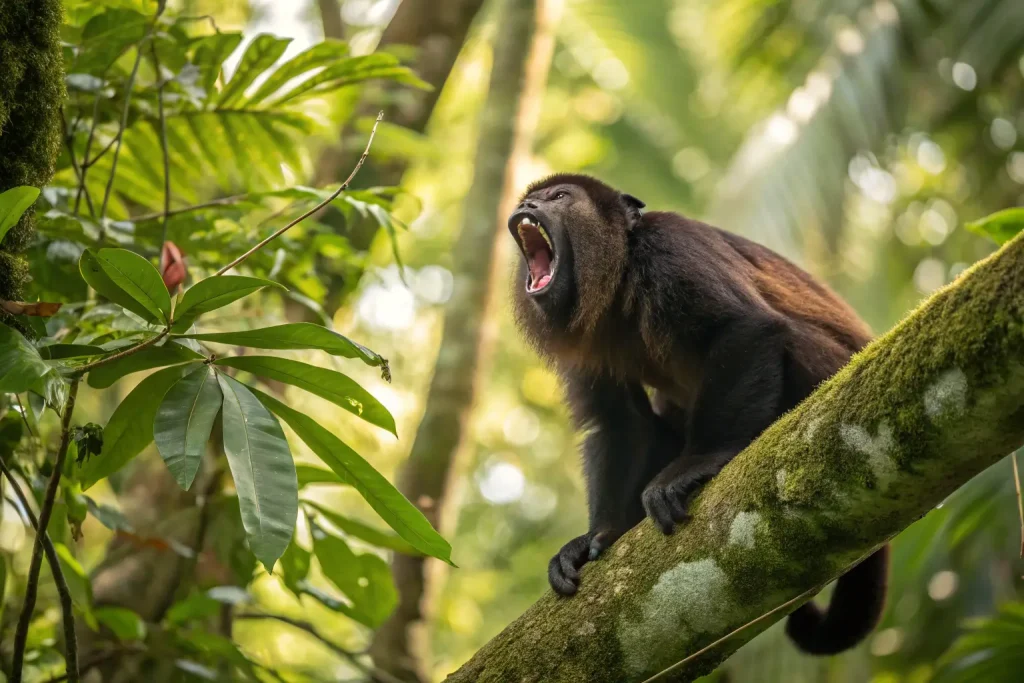
Endangerment Level
The conservation status varies by species. According to the IUCN Red List:
- The Guatemalan black howler (A. pigra): Endangered
- The brown howler (A. guariba): Vulnerable
- The Mexican black howler (A. pigra): Endangered
- The Maranhão red-handed howler (A. ululata): Vulnerable
- The mantled howler (A. palliata): Least Concern
- The red howler (A. seniculus): Least Concern
While some populations remain stable, several species face serious threats, with some local populations experiencing steep declines.
Threats
Howler monkeys face multiple human-caused threats:
- Habitat destruction: Deforestation for agriculture, cattle ranching, and urban development fragments their forest habitat and isolates populations.
- Hunting: Though not as heavily targeted as some primates, they’re still hunted for bushmeat or the pet trade.
- Disease: Yellow fever outbreaks have decimated some populations, particularly in Brazil.
- Climate change: Altering forest composition and fruiting patterns disrupts their food supply.
- Infrastructure development: Roads and power lines create barriers to movement and cause electrocutions.
Conservation Efforts
Several initiatives are working to protect howler monkeys:
- Protected area establishment and expansion in key howler monkey habitats
- Reforestation projects to reconnect fragmented forest patches
- Wildlife corridors to allow movement between isolated populations
- Local education programs about their ecological importance
- Primate rescue and rehabilitation centers for injured or orphaned individuals
- Ecotourism initiatives that provide economic incentives for protection
Conservation organizations like Defenders of Wildlife, the Wildlife Conservation Society, and local groups throughout Latin America are working to ensure these iconic vocal primates continue to fill rainforests with their remarkable sounds.
Interesting Facts
Now, let’s explore seven surprising facts about howler monkeys that showcase just how extraordinary these animals are:
World Record Holders: Male howler monkeys possess the loudest call of any land animal on Earth, with vocalizations reaching up to 140 decibels—louder than a rock concert (120 dB) and just below the pain threshold for human ears (150 dB). This is the definitive answer to what does a howler monkey sound like—LOUD!
Specialized Anatomy: Their hyoid bone is enlarged to create a resonating chamber in their throats. This adaptation is so extreme that male howlers with the largest hyoid bones (and thus loudest calls) typically have smaller testicles—an evolutionary trade-off between vocal dominance and sperm competition.
Slow-Motion Lifestyle: Howlers are among the least active monkeys, moving an average of just 400 meters per day and spending up to 80% of their time resting or sleeping. This energy conservation is necessary due to their leaf-based diet.
Color-Changing Eyes: Baby howler monkeys are born with blue eyes that gradually change to brown as they mature—a trait rarely seen in non-human primates.
Natural Alarm Clocks: Local communities living near howler monkey territories often use their predictable dawn chorus as a natural alarm clock, as the monkeys typically begin howling shortly before sunrise.
Altitudinal Range Shifters: Some howler species have been observed to seasonally shift their altitude in mountainous regions, moving higher during hot periods and lower during cooler months—an unusual behavior showing sophisticated climate adaptation.
Tail-Strength Champions: Their prehensile tails are strong enough to support their entire body weight indefinitely. They even have a specialized bare patch with fingerprint-like ridges on the underside of the tail tip for better grip—essentially a “fifth hand” for life in the trees.
Tips for Observing Howler Monkeys in the Wild
While howler monkeys aren’t kept as pets (and shouldn’t be), many wildlife enthusiasts hope to observe them in their natural habitat. Here are tips for responsible wildlife viewing:
Best Locations for Observation:
- Costa Rica: Monteverde Cloud Forest, Manuel Antonio National Park
- Belize: Community Baboon Sanctuary (despite the name, it protects black howlers)
- Panama: Soberanía National Park
- Mexico: Palenque National Park
- Brazil: Pantanal region
Viewing Tips:
- Visit during early morning (5-8 AM) or late afternoon (4-6 PM) when they’re most active
- Listen for their calls to locate groups
- Bring binoculars (10×42 recommended)
- Wear neutral colors and move quietly
- Maintain at least 15 feet distance to prevent stress
- Never feed wild primates
Photography Tips:
- Use a telephoto lens (at least 200mm)
- Focus on early morning light for best results
- Be patient—howlers move slowly and often remain still for long periods
- Capture their distinctive profile and expressive faces
Ethical Considerations:
- Choose eco-friendly tour operators who follow wildlife viewing guidelines
- Support parks and reserves that protect howler habitat
- Report any signs of illegal wildlife trade or hunting
Role in the Ecosystem
Ecological Importance
Howler monkeys are keystone species in neotropical forests, contributing in several crucial ways:
Seed Dispersal: Despite being primarily leaf-eaters, they consume significant amounts of fruit when available. Seeds pass through their digestive system and are deposited throughout their territory with natural fertilizer, helping maintain forest diversity.
Forest Regeneration: Their preference for young leaves and new growth encourages plant regrowth and helps shape forest structure.
Indicator Species: As large, conspicuous primates sensitive to habitat changes, their presence and behavior provide scientists with information about forest health.
Food Source: As mid-sized primates, they serve as prey for larger predators like harpy eagles and jaguars, helping maintain predator-prey balance.
Nutrient Cycling: Their leaf-heavy diet results in nutrient-rich waste that enhances soil fertility throughout the forest canopy and floor.
Their distinctive vocalizations—what does a howler monkey sound like and why—are not just fascinating but ecologically functional, allowing multiple groups to space themselves efficiently throughout limited forest habitats without constant physical confrontation.
Impact of Decline
The decline or disappearance of howler monkeys would trigger cascading effects:
- Reduced seed dispersal would alter plant community composition, potentially favoring certain species over others
- Predator populations that rely on howlers as prey might decline or switch to alternative prey species
- Other primates might face increased competition or predation pressure
- The “silent forest” phenomenon could occur, where the acoustic environment changes dramatically
- Local human communities might lose cultural connections and ecotourism opportunities
Research shows that forests without howlers or other large primates show measurable differences in vegetation structure and biodiversity over time, underscoring their importance beyond their famous vocalizations.
Conclusion
From their earth-shaking howls to their leisurely lifestyle, howler monkeys embody the magnificent biodiversity of neotropical forests. When we ask “what does a howler monkey sound like?” we’re really exploring a complex evolutionary story of adaptation, social organization, and survival strategy. Their remarkable vocal abilities—capable of projecting over three miles through dense jungle—have evolved not just as a curiosity but as a sophisticated solution to the challenges of rainforest life.
As deforestation continues to fragment their habitat, these vocal guardians of the canopy face an uncertain future. Their calls, once common throughout vast stretches of Latin America, are falling silent in many regions. Yet conservation success stories show that with protected areas, connectivity projects, and local community engagement, howler populations can recover.
The next time you hear recordings of their otherworldly calls or, if you’re fortunate enough, experience them in person, remember that you’re witnessing more than just an impressive natural sound. You’re hearing the voice of healthy forests, complex social societies, and millions of years of evolutionary history. By protecting howler monkeys and their habitat, we ensure that future generations will still be able to ask—and answer—the question: what does a howler monkey sound like?
Frequently Asked Questions
How loud is a howler monkey’s call compared to other sounds?
A howler monkey’s call can reach 140 decibels, comparable to a jet engine at takeoff (140 dB) and louder than a car horn (110 dB), a rock concert (120 dB), or a chainsaw (100 dB). It’s the loudest sound produced by any land animal and can be heard up to 3 miles away through dense jungle.
Why do howler monkeys howl?
Howler monkeys howl for several reasons: to announce their presence to neighboring groups (territorial demarcation), to coordinate group movements, to respond to potential threats, and during mating competition between males. Dawn and dusk howling helps groups space themselves throughout the forest without direct confrontation.
Can you keep a howler monkey as a pet?
No, howler monkeys should not be kept as pets. They’re wild animals with specialized dietary, social, and habitat needs that can’t be met in captivity. Additionally, they’re protected by law in their native countries, and their international trade is regulated under CITES (Convention on International Trade in Endangered Species). Primates also carry zoonotic diseases transmissible to humans.
What time of day are howler monkeys most vocal?
Howler monkeys are typically most vocal at dawn and dusk, with the morning chorus often beginning 30-60 minutes before sunrise. They may also howl during the day in response to disturbances such as predators, thunder, airplanes, or when encountering neighboring groups.
How can I tell male and female howler monkeys apart?
In most howler species, males are larger (15-22 pounds) than females (10-16 pounds) and have more prominent beards or ruffs. In black howlers (Alouatta caraya), males are black while females are blonde-brownish. The most significant difference is that males have a much larger hyoid bone in the throat, visible as a bulge, which enables their louder calls.
What predators do howler monkeys have?
Natural predators of howler monkeys include harpy eagles, crested eagles, jaguars, pumas, ocelots, boa constrictors, and (for infants) tayras and capuchin monkeys. Humans also hunt them in some regions. When threatened, howlers emit alarm calls and flee to higher branches rather than attempting to defend themselves.
Are howler monkeys endangered?
Several howler monkey species face conservation challenges, with the Guatemalan black howler and Mexican black howler listed as Endangered on the IUCN Red List. The brown howler and Maranhão red-handed howler are listed as Vulnerable. While some species maintain stable populations, habitat loss threatens most howlers to varying degrees across their range.
